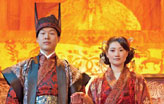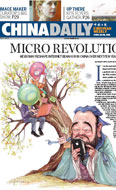Foreign and Military Affairs
Full Text: China's Foreign Aid
Updated: 2011-04-21 17:52
(Xinhua)
Technical Cooperation
Technical cooperation means that China dispatches experts to give technical guidance on production, operation or maintenance of complete projects after they are completed, and train local people as managerial and technical personnel; to help developing countries grow crops, raise animals and process products on a trial basis, and teach local people China's agricultural technologies and traditional handicraft skills; and to help developing countries in inspection, survey, planning, research and consultation work of some industries.
Technical cooperation is an important means by which China helps recipient countries to strengthen their self-development capacity. It covers a wide range of fields, including industrial production and management, farming and poultry raising, handicrafts such as weaving and embroidery, culture and education, sports and physical training, medical and health care, clean energy development such as bio-gas and small hydropower generation, geological survey and prospecting, and economic planning. Technical cooperation projects usually last one to two years, and can be extended at the recipient country's request.
Human Resource Development Cooperation
Human resource development cooperation means that China, through multilateral or bilateral channels, runs different kinds of research and training programs for government officials, education programs, technical training programs, and other personnel exchange programs for developing countries.
China started to run such programs in 1953. From then until 1979, China hosted a large number of trainees from the DPRK, Vietnam, Albania, Cuba, Egypt and some other countries, covering over 20 sectors including agriculture and forestry, water conservancy, light industry, textiles, transportation and health care. Since 1981, China has worked with the United Nations Development Program and hosted training courses in practical techniques in different fields for developing countries. In 1998, the Chinese government began to run seminars for officials. The departments involved and the scale and scope of such training programs have expanded rapidly. By the end of 2009, China had run over 4,000 training sessions of different types for developing countries, attended by some 120,000 people, including interns, managerial and technical personnel and officials. These trainees were from over 20 fields, including economy, diplomacy, agriculture, medical and health care, and environmental protection. At present, roughly 10,000 people from developing countries receive training in China every year. Moreover, China has trained a large number of managerial and technical personnel for recipient countries by means of technical cooperation and other ways.
Chinese Medical Teams Working Abroad
China sends medical teams to recipient countries and provide free medical devices and medicines. These medical teams then provide location-based or touring medical services in those countries.
In 1963, China dispatched the first medical team to Algeria. So far, China has sent medical teams to 69 countries in Asia, Africa, Europe, Latin America, the Caribbean and Oceania. These teams usually work in underdeveloped areas where conditions are harsh and people lack medical services and medicines. These teams have cured many patients with common and frequently occurring diseases, and treated some complicated and serious diseases with acupuncture and moxibustion, medical massage and integrated use of traditional Chinese and Western medicine, saving many critically ill patients. They have also passed on their skills to local medical staff, helping improve local medical and health services. With sound medical skills, lofty medical ethics and a high sense of responsibility and mission, they have worked hard to serve the people of the recipient countries, and thus won respect and praise from the governments and peoples of these countries. By the end of 2009, China had altogether sent over 21,000 medical workers to other countries, and they have treated 260 million patients in the recipient countries. In 2009, 60 Chinese medical teams composed of 1,324 members provided medical services at 130 medical institutions in 57 developing countries.
E-paper

Han me downs
Traditional 3,000-year-old clothes are making a comeback.
Preview of the coming issue
Reaching out
Fast growth fuels rise in super rich
Specials

25 years after Chernobyl
Belarus, Ukraine and Russia will mark the 25th anniversary of the nuclear reactor explosion in Chernobyl.

Luxury car show
The world's most prestigious luxury, sports cars and supercars are displayed in Monaco.

Peking Opera revival
Traditional opera is enjoying a revival in Beijing thanks to some modern touches.
